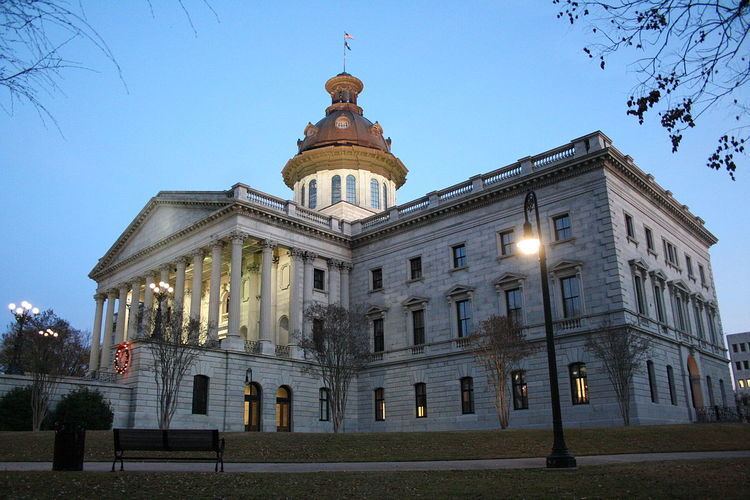Architectural style Greek Revival Area 4 ha Architect John Rudolph Niernsee | NRHP Reference # 70000598 Phone +1 803-734-2430 | |
 | ||
Built 1855; 162 years ago (1855) Added to NRHP June 5, 1970; 46 years ago (1970-06-05) Designated NHL May 11, 1976; 40 years ago (1976-05-11) Address 1100 Gervais St, Columbia, SC 29201, USA Hours Closed now Monday9AM–5PMTuesday9AM–5PMWednesday9AM–5PMThursday9AM–5PMFriday9AM–5PMSaturday10AM–4PMSundayClosedSuggest an edit Similar Emanuel African Methodist, Riverbanks Zoo, South Carolina State Mus, EdVenture, Finlay Park | ||
Discover the south carolina state house
The South Carolina State House is the building housing the government of the U.S. state of South Carolina. The building houses the South Carolina General Assembly and the offices of the Governor and Lieutenant Governor of South Carolina. Until 1971, it also housed the Supreme Court. It is located in the capital city of Columbia near the corner of Gervais and Assembly Streets.
Contents
- Discover the south carolina state house
- South carolina state house grounds google glass tour
- Architecture
- Grounds
- References
The State House is in the Greek Revival style; it is approximately 180 feet (55 m) tall, 300 feet (91 m) long, 100 feet (30 m) wide. It weighs more than 70,000 short tons (64,000 t) and has 130,673 square feet (12,140 m2) of space.
South carolina state house grounds google glass tour
Architecture
The South Carolina State House was designed first by architect P. H. Hammarskold. Construction began in 1851, but the original architect was dismissed for fraud and dereliction of duty. Soon thereafter, the structure was largely dismantled because of defective materials and workmanship. John Niernsee redesigned the structure and work began on it in 1855, slowed during the Civil War, and was suspended in 1865 as General W.T. Sherman's U.S. Army entered Columbia on February 17. Several public buildings were "put to the torch" when United States troops entered the city.
The capitol building was damaged by artillery shells and set afire by U.S. Army troops under Sherman's command.
Building work was finally completed in 1907. The reconstruction era poverty slowed progress. The building's main structure was finally completed in 1875. From 1888 to 1891, Niernsee’s son, Frank McHenry Niernsee, served as architect and much of the interior work was completed. In 1900 Frank Pierce Milburn began as architect, but was replaced in 1905 by Charles Coker Wilson who finally finished the exterior in 1907. Additional renovations were made in 1959 and 1998.
The State House was designated a National Historic Landmark in 1976 for its significance in the post-Civil War Reconstruction Era.
Grounds
The building's grounds are home to several monuments. On the north side, leading to the main entry, is the Confederate Monument which included a flagpole flying a traditional version of the Confederate battle flag until it was removed on July 10, 2015 by State Bill. The monument was established after a controversy during the state's 2000 presidential primary about the Confederate flag flying over the dome of the State House. The flag, which was originally placed over the dome in 1962 by the state's governor, Democrat Ernest Hollings, to protest desegregation, was moved near the monument on July 1, 2000, after passage of the South Carolina Heritage Act of 2000. It was then removed from the grounds on July 10, 2015 by order of Republican governor Nimrata Haley, and given to the South Carolina Confederate Relic Room and Military Museum.
On the east side is the African-American History Monument, authorized by Act 457 of the General Assembly and unveiled on March 26, 2001.
The grounds also include monuments to President George Washington, Revolutionary War Generals, the Palmetto Regiment of, the American-Mexican War, Wade Hampton III, Captain Swanson Lunsford, Confederate Women, U.S. Senators James F. Byrnes, Strom Thurmond and Benjamin Tillman, Dr. J. Marion Sims, and South Carolinian law enforcement officers killed while on duty.
